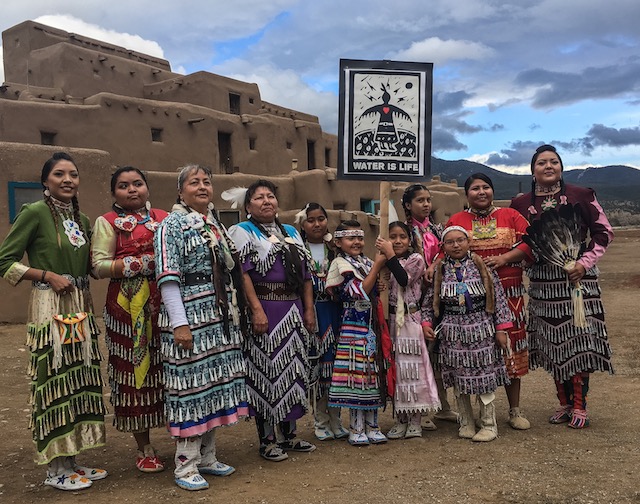
The man slumped to the left of the photograph is barely holding back tears.
Despite his natty pin-striped suit, he looks as though he has just lost a loved one. Others standing around him look equally grim. In the foreground, another man sits at a large desk and signs documents. His face is cold and hard as if deliberately ignoring the distraught individual sobbing right behind him.
He most likely is. The man with the pen is Secretary of the Interior, J. A. Krug. He is signing a contract to buy 155,000 acres of prime land from the Mandan, Arikara and Hidatsa Indian nations living on the Fort Berthold reservation in North Dakota. The weeping man behind him is George Gillette, chairman of the Fort Berthold Tribal Council. The date of the AP photograph is May 20, 1948.
It doesn’t take much perception to realize that this “agreement” was more of an act of coercion—hence, Gillette’s stricken features. The Federal government wanted to build a reservoir and strong-armed the Native Americans into complying. The reservoir in question, built by the Army Corps of Engineers along with the adjoining Garrison Dam, flooded 94 percent of the reservation’s arable farmland and essentially destroyed their traditional way of life.
Although compensated with $7,000,000, the Indians were prohibited from hunting, grazing or fishing along the reservoir shoreline and denied royalties to any mineral rights found in the area. The three tribes only agreed because they were threatened by imminent domain. The lake formed by the dam was named Lake Sakakawea, in honor of the young Shoshone woman who guided Lewis and Clark to the Pacific in 1803.
If this dismal story sounds familiar, it’s because it was not the first time—and surely not the last—that native peoples have been bullied to either give up or jeopardize their land because of outside forces. Through this episode from nearly seventy years past, readers might get some idea as to the outrage and determination of the Lakota Standing Rock nation and their native allies to resist the planned DAPL pipeline under the Missouri River.
When Obama announced suspension of the DAPL project in December 2016, I was happy but not completely ecstatic. I feared that President-elect Donald Trump and the Republican congressional majority would not hesitate to overturn Obama’s decision. And, as we have recently seen, President Trump has signed an executive order doing just that. When having to decide between greed and the needs of a community of impoverished and powerless Indians, it is no surprise which way the wind will blow.
The story of the Standing Rock resistance is now known to most literate Americans. What might not be is the remarkable way it began.
In April 2016, Standing Rock tribal elder, LaDonna Brave Bull Allard put out a call on Facebook asking for support against the planned pipeline. According to her, she expected perhaps forty responses, probably in the form of sympathetic “likes.” It is doubtful she envisioned 10,000 people from across the nation and the world flocking to an isolated pocket of North Dakota to set up camp and give support. Like Gandhi’s 1930 March to the Sea and the 1965 Selma to Montgomery March during the Civil Rights era, the Water Protectors of Standing Rock have become an international symbol of non-violent “People Power” against an entrenched system of oppression.
Throughout the centuries, Native Americans across the continent have had every one of their legitimate treaties violated or abrogated. The Lakota Sioux have been singled out for additional mistreatment because they had the audacity to defeat the United States military no less than three times within a decade. The Americans got their revenge through the unwarranted murders of revered leaders like Crazy Horse and Sitting Bull (shot to death at Standing Rock in 1890) and the massacre at Wounded Knee perpetrated by the 7th Cavalry. Since 1887, when the Great Sioux Reservation was broken up by the Dawes Act, the Lakota saw even more of their ancestral lands seized for Federal water-control projects.
For non-natives, these are merely historical facts. For the Lakota and other native peoples, it is a bitterness that will never be forgotten, no different than Jews forgetting the Holocaust or African-Americans deleting the Ku Klux Klan out of their collective consciousness.
At some point, a people needs to draw a line in the sand and declare “Enough” and “Never again.” For the Native Nations from South America to northern Canada, that moment has arrived at Standing Rock.
~
Author: Daniel A. Brown
Images: Author’s own
Editor: Erin Lawson






Read 1 comment and reply